Nov. 6, 2025
Conferences

🌐Subscribe to the Newsletter MAFR Regulation, Compliance, Law
🌐Subscribe to the video newsletter MAFR Overhang
🌐Subscribe to the Newsletter MaFR Law & Art
____
► Full reference : M.-A. Frison-Roche, "Concevoir une Raison d'être et l'explicitre (Conceiving a Raison d'être and explaining it)", speech at the round table discussion "Dire sa Raison d'être (Expressing your Raison d'être)", National Conference of the Géomètres Expert (French Chartered Surveyors), 6 November 2025, Paris.
____
► Presentation of the Round Table : This round table opens two days of work bringing together all the leaders, members of the Council of the Order of Chartered Surveyors and Regional Councils of Chartered Surveyors, in the presence of the relevant Ministry, in specific sessions during which the two Raison d'être that have been developed over several years of work and adopted, the Raison d'être of the profession and the Raison d'être of the Order, are presented.
🪑🪑🪑Other participants in the round table discussion, moderated by Hervé Grélard, General Deputy of the French Order of Chartered Surveyors:
🕴🏻Thomas Bonnel, chartered surveyor
🕴🏻Luc Lanoy, chartered surveyor,
🕴🏻Séverine Vernet, Chairwoman of the French Order of Chartered Surveyors
____
► Summary of my presentation : Firstly, I spoke to remind everyone what a "raison d'être" is, in itself, and why it is particularly important when the entity that embodies it also constitutes a "profession", the raison d'être expressing this hybrid nature that is destined to endure in today's societies. It moves those who uphold the raison d'être – the professional, the profession, the umbrella organisation that is the Order – from the past to the future. To effectively carry this raison d'être, its bearer cannot remain isolated. Unlike the agent who operates in a market and whose strategy is solitary dynamism against others, the bearer of the raison d'être must find allies who share similar or compatible ideas and develop points of contact to carry out a collective project (the "Monumental Goals"). This is why it is just as important to communicate, explain and share the raison d'être with the outside world.
Secondly, as the discussion surrounding the statement of purpose of the French Order of Surveyors and the profession progressed, I was led to point out that the raison d'être is not, or not only, ethical in nature, but also legal in nature, constituting at the very least a legal fact that can become enforceable against those who recognise themselves in it and claim it. This kind of reward, which is the "ex ante responsibility" expressed by the raison d'être and relayed by Compliance Law, anchored in its monumental goals of sustainability and responsibility, justifies that the profession that embraces its raison d'être is not simply an efficient profession in a supply and demand market, but establishes the Order as a regulator. This places both in the long term.
________
⛏️Further reading on the subject: (with English Summaries)
🕴🏻M.-A. Frison-Roche, 💬"Géomètres-experts : une profession qui assume concrètement sa responsabilité territoriale", 2025
🕴🏻M.-A. Frison-Roche, 📝A quoi engagent les engagements, 2025
🕴🏻M.-A. Frison-Roche et 🕴🏻S. Vernet, 📝La profession investit le Droit de la compliance et détermine sa Raison d'être, 2023
🕴🏻M.-A. Frison-Roche, 📧Quels sont les points de contact entre la Raison d'être des entreprises et le Droit de la Compliance ?, 2022
________
Aug. 3, 2025
Law by Illustrations
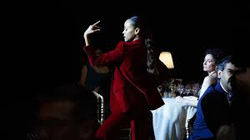
🌐suivre Marie-Anne Frison-Roche sur LinkedIn
🌐s'abonner à la Newsletter MAFR Regulation, Compliance, Law
🌐s'abonner à la Newsletter en vidéo MAFR Surplomb
► Référence complète : M.-A. Frison-Roche, "A côté d'𝑬𝒎𝒊𝒍𝒊𝒂 𝑷𝒆𝒓𝒆𝒛, quels principes guident l'Avocate ?", article de la Newsletter Droit & Art, août 2025.
____
___
► Résumé de l'article : Dans le film de Jacques Audiard sorti en 2024, le personnage de l'Avocate ouvre et clôture le film.Si l'on centre son regard sur elle, l'on observera qu'elle est choisie par le client parce qu'elle a la capacité à lui procurer dans l'ombre et sans souci du Droit ce qu'il veut. La corruption étant un système qui lui est familier. Cette conception d'un office où le Droit a peu de place la conduit à s'opposer au conseil donné par le médecin. Ainsi à de nombreuses reprises elle exprime sa désapprobation, morale et sociale, pour ce qui se passe et qu'elle connait avec précision, mais cela ne modifie en rien son comportement.Plutôt que de suivre ici les décisions, les tourments, l'identité, le rapport au passé du criminel, concentrons le regard sur la professionnelle qui ouvre et clôt le film : l'avocate. Regardons plutôt les décisions successives de cette avocate, la représentation qui est donnée ce que l'avocat doit faire ou ne pas faire.
Il s'agit donc d'une avocate qui est choisie par ce client pour une qualité : sa capacité à donner dans l'ombre satisfaction à un client qui, au regard du Droit, ne le mérite pas (I). Un criminel avéré, chef d'un réseau de trafic de drogue, la choisit pour une activité où le secret doit être absolu et la dimension juridique peu présente. Dans les démarches dont elle est chargée, elle est confrontée à un médecin, qui ne développe pas la même conception qu'elle et lui conseille de conseiller à son client de ne pas persévérer (II). Dans son âme et conscience, elle désapprouve la corruption qui structure l'ensemble de la société et dont elle semble tout savoir, mais cela ne modifie pas son comportement (III). Pourtant in fine et sans qu'on l'y oblige elle prendra dans une image finale soin des enfants devenus soudainement orphelins (IV).
____
lire l'article complet ci-dessous

Updated: June 5, 2025 (Initial publication: June 20, 2024)
Publications

🌐follow Marie-Anne Frison-Roche on LinkedIn
🌐subscribe to the Newsletter MAFR Regulation, Compliance, Law
🌐subscribe to the Video Newsletter MAFR Surplomb
____
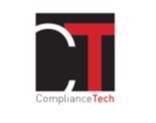 ► Full Reference: M.-A. Frison-Roche, The will, the heart and the calculation, the three traits encercling the Compliance Obligation, March 2024.
► Full Reference: M.-A. Frison-Roche, The will, the heart and the calculation, the three traits encercling the Compliance Obligation, March 2024.
____
📝 This Working Paper is the basis for the contribution "The will, the heart and the calculation, the three traits encercling the Compliance Obligation", in📘Compliance Obligation.
____
► Summary of this Working Paper: There is often a dispute over the pertinent definition of Compliance Law, but the scale and force of the resulting obligation for the companies subject to it is clear. It remains difficult to define. First, we must not to be overwhelmed by the many obligations through which the Compliance Obligation takes shape, such as the obligation to map, to investigate, to be vigilant, to sanction, to educate, to collaborate, and so on. Not only this obligations list is very long, it is also open-ended, with companies themselves and judges adding to it as and when companies, sectors and cases require.
Nor should we be led astray by the distance that can be drawn between the contours of this Compliance Obligation, which can be as much a matter of will, a generous feeling for a close or distant other in space or time, or the result of a calculation. This plurality does not pose a problem if we do not concentrate all our efforts on distinguishing these secondary obligations from one another but on measuring what they are the implementation of, this Compliance Obligation which ensures that entities, companies, stakeholders and public authorities, contribute to achieving the Goals targeted by Compliance Law, Monumental Goals which give unity to the Compliance Obligation. Thus unified by the same spirit, the implementation of all these secondary obligations, which seem at once disparate, innumerable and often mechanical, find unity in their regime and the way in which Regulators and Judges must control, sanction and extend them, since the Compliance Obligation breathes a common spirit into them.
In the same way that the multiplicity of compliance techniques must not mask the uniqueness of the Compliance Obligation, the multiplicity of sources must not produce a similar screen. Indeed, the Legislator has often issued a prescription, an order with which companies must comply, Compliance then often being perceived as required obedience. But the company itself expresses a will that is autonomous from that of the Legislator, the vocabulary of self-regulation and/or ethics being used in this perspective, because it affirms that it devotes forces to taking into consideration the situation of others when it would not be compelled to do so, but that it does so nonetheless because it cares about them. However, the management of reputational risks and the value of bonds of trust, or a suspicious reading of managerial choices, lead us to say that all this is merely a calculation.
Thus, the contribution sets out to identify the Compliance Obligation by recognising the role of all these different sources. It emphasises that, in monitoring the proper performance of technical compliance obligations by Managers, Regulators and Judges, insofar as they implement the Compliance Obligation, it is pointless to limit oneself to a single source or to rank them abruptly in order of importance. The Compliance Obligation is part of the very definition of Compliance Law, built on the political ambition to achieve these Monumental Goals of preserving systems - banking, financial, energy, digital, etc. - in the future, so that human beings who cannot but depend on them are not crushed by them, or even benefit from them. This is the teleological yardstick by which the Compliance Obligation is measured, and with it all the secondary obligations that give it concrete form, whatever their source and whatever the reason why the initial standard was adopted.
In order to define Compliance's Obligation, the contribution endeavours to recognise the contribution of all these three sources: Will, Heart and Calculation.
_____
🔓read the developments below ⤵️
Feb. 29, 2024
Publications
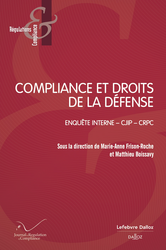
🌐follow Marie-Anne Frison-Roche on LinkedIn
🌐subscribe to the Newsletter MAFR Regulation, Compliance, Law
____
► Full Reference: M.-A. Frison-Roche & M. Boissavy (eds.), Compliance et droits de la défense. Enquête interne – CJIP – CRPC (Compliance and rights of the defence. Internal investigation – French Judicial Public Interest Agreement – French guilty plea procedure), Journal of Regulation & Compliance (JoRC) and Dalloz, "Régulations & Compliance" Serie, 2024, 362 p.
____
► General presentation of the book: We do not have an overall view of the relationship between Compliance and the rights of the defence in the continuum of internal investigations and DPA, or in the French legal system the convention judiciaire d'intérêt public (CJIP) and the comparution immédiate avec reconnaissance de culpabilité (CRPC), in particular because the texts, whether hard law or soft law, decisions and academic analyses segment them, making it difficult to build a pertinent appreciation of each one. This is made all the more difficult by the fact that we know little about how each of them is applied in practice, both within each of them and in relation to each other. As a result, it is difficult to express overall satisfaction, or total rejection, or to suggest some specific reforms and to precise on what points, to identify the appropriate source of these improvements, legislation, case law, professions, or spontaneous ways of doing. The first ambition of this book is therefore to restore an overall vision, because this is the vision of practice. If shortcomings are found to exist, then they can be more easily denounced.
However, some of the situations described may be described as flawed, or even dramatic, by some, while others may consider that they should be approved as they stand. This applies, for example, to the question of whether or not the investigation report should be secret from the prosecuting authority, which may propose a DPA (or in the French legal system a CJIP), whether or not this CJIP should be extended to individuals, whether or not a lawyer should be present from the internal investigation stage onwards, whether or not the lawyer should support the interests of the company he/she is investigating and continue to do so before the regulator or the prosecutor, whether or not the investigation is delegated from the public authorities to the company, whether or not the lawyer-investigator and then the lawyer-defendant are both lawyers, whether or not the victims are represented in the the CIPC process, etc. Depending on what one thinks the relation between Compliance and due process should be in principle and in practice, one expresses a more or less approving or severe judgement on the state of the texts, the soft law nature of most of them making the exercise complicated, and then if there is a gap between them and what one thinks should be the right standard, one asserts that in practice things happen differently from what the texts say, or one considers that the texts should be changed. From point to point, a veritable kaleidoscope emerges in this book.
Indeed, the result is a series of contributions that sometimes clash with one another, with a sort of contradictionary principle creeping into the very structure of this book, thus establishing the readesr as a sort of judges themselves , that character who is so absent. He/she will be able to do so, since the book lists texts, describes practices and gives an illustration of everything that can be thought of, in visions that are sometimes analytical and sometimes global, with proposals of reforms of texts, jurisprudence or conduct.
The aim of the book is to enable readers to form their own opinions and to take part in what is undoubtedly being strongly debated today: the confrontation between Compliance and rights of the defence.
____
► Summary of the book: The rights of the defence are one of the pillars of our Rule of Law. On the face of it, compliance techniques are not concerned with this under the pretext of efficiency. This would be particularly true in a trilogy that unfolds over time: internal investigation, convention judiciaire d'intérêt public - CJIP (French Judicial Public Interest Agreement) and comparution sur reconnaissance préalable de culpabilité - CRPC (French guilty plea procedure).
However, because Compliance Law is also the expression of the Rule of Law, in that its ambition is to detect and prevent systemic risks in order to protect present and future human beings, we must go beyond this opposition and articulate Compliance and rights of the defence.
The Monumental Goals of Compliance, which justify its power, for example to obtain information, and the fundamental rights of the defence, which for example impose the presumption of innocence, must be adjusted to each other; by interpreting texts, or even adopting new ones.
The book analyses each of these three techniques, in particular the still largely unregulated internal investigation, and sheds light on them in relation to each other, in order to formulate proposals.
____
🏗️General construction of the book: The book opens with an overview divided into three sections. The first Title compares the challenges of the internal investigation with the rights of the defence. The second Title compares the issues at stake in the convention judiciaire d'intérêt public - CJIP (French Judicial Public Interest Agreement) and the comparution sur reconnaissance préalable de culpabilité - CRPC (French guilty plea procedure) with these same rights of the defence.
____
TABLE OF CONTENTS
COMPLIANCE ET DROITS DE LA DÉFENSE : VISION D'ENSEMBLE
(COMPLIANCE AND RIGHTS OF THE DEFENCE : OVERVIEW)
Section 2 ♦️ Compliance et droits de la défense : toujours pour le respect des droits humains (Compliance and rights of the defence: always for the respect of human rights), by🕴️Matthieu Boissavy
Section 3 ♦️ Circuler dans le temps pour mettre en phase Compliance et droits de la défense (Moving through Time to align Compliance and rights of the defence), by🕴️Marie-Anne Frison-Roche
TITRE I.
LES ENJEUX PROCÉDURAUX DE L'ENQUETE INTERNE CONFRONTÉE AUX DROITS DE LA DÉFENSE
(TITLE I.
PROCEDURAL CHALLENGES OF THE INTERNAL INVESTIGATION
IN RELATION TO THE RIGHTS OF THE DEFENCE)
CHAPITRE I : VISION GÉNÉRALE DES DROITS DE LA DÉFENSE DANS L'ENQUÊTE INTERNE
(CHAPTER I: OVERVIEW OF THE RIGHTS OF THE DEFENCE IN INTERNAL INVESTIGATION)
Section 1 ♦️ Approche doctrinale de l’enquête interne et de l’enquête pénale privée (Doctrinal approach to internal investigation and private criminal investigation), by 🕴️Benjamin Fiorini
Section 2 ♦️ Regard critique : La place des droits de la défense dans l'enquête interne selon le guide AFA/PNF (A critical look: The place of the rights of the defence in the internal investigation according to the AFA/PNF Guide), by 🕴️Margaux Durand-Poincloux, 🕴️David Apelbaum and 🕴️Paola Sardi-Antasan
CHAPITRE II : LES DROITS DE LA DÉFENSE À CHAQUE ÉTAPE DE L'ENQUÊTE INTERNE
(CHAPTER II: THE RIGHTS OF THE DEFENCE AT EACH STAGE OF THE INTERNAL INVESTIGATION)
Section 1 ♦️ La réception des alertes par l'avocat (Reception of alerts by the lawyer), by🕴️Maria Lancri
Section 2 ♦️ Collecte et traitement des informations dans les enquêtes internes à l'ère numérique : processus et enjeux (Collecting and processing information for internal investigations in the digital age: processes and challenges), by🕴️Uriel Goldberg
Section 3 ♦️ L’apport de la psychologie pour l'effectivité des droits de la défense dans l'enquête interne pour harcèlement au travail (The contribution of psychology to the effectiveness of the rights of the defence in internal investigation for harassment in the workplace), by🕴️Nathalie Leroy & 🕴️Danièle Zucker
Section 4 ♦️ Le respect des droits de la défense lors des auditions des enquêtes internes : un gage d’efficacité (Respecting the rights of the defence during hearings in internal investigations: a guarantee of efficacy), by 🕴️Emmanuel Daoud & 🕴️Ghita Khalid Rouissi
Section 5 ♦️ L’enquête interne au cœur des enjeux de conformité et de justice négociée : analyse de la position de l'AFA et du PNF (The internal investigation at the heart of conformity and negotiated justice issues: analysis of the position of the AFA and the PNF), by🕴️Éric Russo
Section 6 ♦️ Le rapport d’enquête interne à l’épreuve des droits de la défense (The internal investigation report put to the test of defence rights), by🕴️Samuel Sauphanor
CHAPITRE III : LA SPÉCIFICITÉ DES ENQUÊTES INTERNES DANS LES ENTREPRISES INTERNATIONALES ET LA PLACE DES DROITS DE LA DÉFENSE
(CHAPTER III : SPECIFICITY OF INTERNAL INVESTIGATIONS IN INTERNATIONAL COMPANIES AND THE PLACE OF THE RIGHTS OF THE DEFENCE)
Section 1 ♦️ La spécificité des enquêtes internes pratiquées par les groupes internationaux (Specificity of internal investigations carried out by international groups), by 🕴️Olivier Catherine
Section 2 ♦️ Garantir la valeur probatoire d’un rapport dans le cadre d’une enquête interne opérée dans une entreprise internationale (Guaranteeing the evidential value of a report in an internal investigation carried out in an international company), by 🕴️Monique Figueiredo
Section 3 ♦️ La responsabilité de l'entreprise dans la conception et la menée de l'enquête interne (The company's responsibility in designing and conducting an internal investigation), by 🕴️Lydia Meziani
Section 4 ♦️ Enquêtes internes, enquêtes pénales et droits de la défense : que nous disent les jurisprudences américaine et anglaise (l’affaire Connolly et l’affaire ENRC) ? (Internal investigations, criminal investigations and rights of the defence: what do the US and UK case law tell us (the Connolly case and the ENRC case)?), by 🕴️Victoire Chatelin
CHAPITRE IV : LE RÔLE SINGULIER DE L'AVOCAT DANS L'ENQUÊTE INTERNE
(CHAPTER IV: THE SPECIAL ROLE OF THE LAWYER IN THE INTERNAL INVESTIGATION)
Section 1 ♦️ La méthodologie propre à l'avocat enquêteur (The investigating lawyer's own methodology), by 🕴️William Feugère
Section 2 ♦️ L'enquête interne façonnée par la déontologie de l'avocat (The internal investigation shaped by the lawyer's deontology), by 🕴️Stéphane De Navacelle, 🕴️Julie Zorrila and 🕴️Laura Ragazzi
Section 3 ♦️ Préserver le secret professionnel de l'avocat dans l'enquête interne et son résultat (Preserving the lawyer's professional secrecy in the internal investigation and its outcome), by 🕴️Bénédicte Graulle & 🕴️Yanis Rahim
Section 4 ♦️ L’avocat-enquêteur en droit du travail : un janséniste au milieu du Far West (The lawyer-investigator in employment law: a Jansenist in the Wild West), by 🕴️Richard Doudet
Section 5 ♦️ La défense des personnes physiques dans les enquêtes internes (Defending individuals in internal investigations), by 🕴️Dorothée Hever
TITRE II.
LES ENJEUX PROCÉDURAUX DE LA CJIP ET DE LA CRPC
CONFRONTÉES AUX DROITS DE LA DÉFENSE
(TITLE II.
PROCEDURAL CHALLENGES OF THE FRENCH JUDICIAL PUBLIC INTEREST AGREEMENT
AND THE FRENCH GUILTY PLEA PROCEDURE
IN RELATION TO THE RIGHTS OF THE DEFENCE)
CHAPITRE I : VISION GÉNÉRALE DES DROITS DE LA DÉFENSE DANS LA CJIP ET LA CRPC
(CHAPTER I: OVERVIEW OF THE RIGHTS OF THE DEFENCE IN THE FRENCH JUDICIAL PUBLIC INTEREST AGREEMENT AND THE FRENCH GUILTY PLEA PROCEDURE)
Section 1 ♦️ Théorie et pratique de la négociation dans la justice pénale (Theory and practice of negotiation in criminal justice), by 🕴️Sarah-Marie Cabon
Section 2 ♦️ La lutte anti-corruption : l’emprunt au modèle américain et à ses récentes évolutions (The fight against corruption: borrowing from the American model and its recent developments), by 🕴️Stephen L. Dreyfuss
Section 3 ♦️ Justice pénale négociée : avantages présents, risques à venir (Negotiated criminal justice: curent benefits, future risks), by 🕴️Alexis Bavitot
CHAPITRE II : FORMES ACTIVES DES DROITS DE LA DÉFENSE, LES DIALOGUES À L'OEUVRE OU À PARFAIRE DANS LA CJIP ET LA CRPC
(CHAPTER II: ACTIVE FORMS OF THE RIGHTS OF THE DEFENCE, DIALOGUES AT WORK OR TO BE PERFECTED IN THE FRENCH JUDICIAL PUBLIC INTEREST AGREEMENT AND THE FRENCH GUILTY PLEA PROCEDURE)
Section 1 ♦️ Combinaison des CRPC et des CJIP : le cas particulier des affaires de fraude fiscale (Combination of the French guilty plea procedure and the French Judicial Public Interest Agreement: the special issue of tax fraud cases), by 🕴️Marion David
Section 2 ♦️ Pour une justice pénale négociée plus équitable (For a fairer negotiated criminal justice), by🕴️Astrid Mignon Colombet
Section 3 ♦️ Les impacts, sur les droits de la défense, des disparités de la justice pénale négociée dans l’Union européenne (The impact on the rights of the defence of the disparities in negotiated criminal justice in the European Union), by 🕴️Emmanuel Moyne
Section 4 ♦️ L'évolution des rapports entre avocats et autorités de poursuites depuis l'introduction de la CJIP (Developments in relations between lawyers and prosecuting authorities since the introduction of the French Judicial Public Interest Agreement), by 🕴️Thomas Baudesson
CHAPITRE III : LE RÔLE SINGULIER DE L'AVOCAT DANS LA CJIP ET LA CRPC
(CHAPTER III: THE SINGULAR ROLE OF THE LAWYER IN THE FRENCH JUDICIAL PUBLIC INTEREST AGREEMENT AND THE FRENCH GUILTY PLEA PROCEDURE)
Section 1 ♦️ Quand se justifie et quand s'arrête la collaboration ? À propos de la CJIP (When is collaboration justified and when does it end? About the French Judicial Public Interest Agreement), by 🕴️Philippe Goossens
Section 2 ♦️ Le dialogue de l’avocat et de son client, chef d’entreprise, face à la proposition d’une CRPC et d’une CJIP (The dialogue between the lawyer and his client, a company director, faced with the proposal of a French guilty plea procedure or a French Judicial Public Interest Agreement), by 🕴️François Saint-Pierre
Section 3 ♦️ Le dilemme de l'avocat pénaliste face à la CRPC (The criminal lawyer's dilemma when faced with the French guilty plea procedure), by 🕴️Jean Boudot
Section 5 ♦️ Défendre les intérêts des victimes dans la justice pénale économique négociée (Defending victims' interests in negotiated economic criminal justice), by 🕴️Jérôme Karsenti
________
Feb. 29, 2024
Editorial responsibilities : Direction of the collection "Regulations & Compliance", JoRC & Dalloz

🌐follow Marie-Anne Frison-Roche on LinkedIn
🌐subscribe to the Newsletter MAFR Regulation, Compliance, Law
____
► Full Reference: M.-A. Frison-Roche & M. Boissavy (eds.), Compliance et droits de la défense. Enquête interne – CJIP – CRPC (Compliance and rights of the defence. Internal investigation – French Judicial Public Interest Agreement – French guilty plea procedure), Journal of Regulation & Compliance (JoRC) and Dalloz, "Régulations & Compliance" Serie, 2024, 362 p.
____
► General presentation of the book: We do not have an overall view of the relationship between Compliance and the rights of the defence in the continuum of internal investigations and DPA, or in the French legal system the convention judiciaire d'intérêt public (CJIP) and the comparution immédiate avec reconnaissance de culpabilité (CRPC), in particular because the texts, whether hard law or soft law, decisions and academic analyses segment them, making it difficult to build a pertinent appreciation of each one. This is made all the more difficult by the fact that we know little about how each of them is applied in practice, both within each of them and in relation to each other. As a result, it is difficult to express overall satisfaction, or total rejection, or to suggest some specific reforms and to precise on what points, to identify the appropriate source of these improvements, legislation, case law, professions, or spontaneous ways of doing. The first ambition of this book is therefore to restore an overall vision, because this is the vision of practice. If shortcomings are found to exist, then they can be more easily denounced.
However, some of the situations described may be described as flawed, or even dramatic, by some, while others may consider that they should be approved as they stand. This applies, for example, to the question of whether or not the investigation report should be secret from the prosecuting authority, which may propose a DPA (or in the French legal system a CJIP), whether or not this CJIP should be extended to individuals, whether or not a lawyer should be present from the internal investigation stage onwards, whether or not the lawyer should support the interests of the company he/she is investigating and continue to do so before the regulator or the prosecutor, whether or not the investigation is delegated from the public authorities to the company, whether or not the lawyer-investigator and then the lawyer-defendant are both lawyers, whether or not the victims are represented in the the CIPC process, etc. Depending on what one thinks the relation between Compliance and due process should be in principle and in practice, one expresses a more or less approving or severe judgement on the state of the texts, the soft law nature of most of them making the exercise complicated, and then if there is a gap between them and what one thinks should be the right standard, one asserts that in practice things happen differently from what the texts say, or one considers that the texts should be changed. From point to point, a veritable kaleidoscope emerges in this book.
Indeed, the result is a series of contributions that sometimes clash with one another, with a sort of contradictionary principle creeping into the very structure of this book, thus establishing the readesr as a sort of judges themselves , that character who is so absent. He/she will be able to do so, since the book lists texts, describes practices and gives an illustration of everything that can be thought of, in visions that are sometimes analytical and sometimes global, with proposals of reforms of texts, jurisprudence or conduct.
The aim of the book is to enable readers to form their own opinions and to take part in what is undoubtedly being strongly debated today: the confrontation between Compliance and rights of the defence.
____
🧮this book follows a conference organised by the Conseil national des barreaux - CNB (French National Council of Lawyers), which took place on 20 and 21 April 2023: Avocats et droits de la défense dans les enquêtes internes et la justice négociée.
____
This volume is the continuation of the books dedicated to Compliance in this collection.
📚 Read the presentations of the other books on Compliance in this collection:
- further books:
🕴️M.-A. Frison-Roche (ed.), 📕Le système probatoire de la compliance, 2025
🕴️M.-A. Frison-Roche (ed.), 📕Compliance et contrat, 2024
🕴️M.-A. Frison-Roche (ed.), 📕L'Obligation de Compliance, 2024
- previous books:
🕴️M.-A. Frison-Roche (dir.), 📕La juridictionnalisation de la Compliance, 2023
🕴️M.-A. Frison-Roche (ed.), 📕Les Buts Monumentaux de la Compliance, 2022
🕴️M.-A. Frison-Roche (ed.), 📕Les outils de la Compliance, 2021
🕴️M.-A. Frison-Roche (ed.), 📕Pour une Europe de la Compliance, 2019
🕴️N. Borga, N., 🕴️J.-Cl. Marin & 🕴️J.-Ch. Roda (eds.), 📕Compliance : Entreprise, Régulateur, Juge, 2018
🕴️M.-A. Frison-Roche (ed.), 📕Régulation, Supervision, Compliance, 2017
🕴️M.-A. Frison-Roche (ed.), 📕Internet, espace d'interrégulation, 2016
📚Read the presentations of the other titles of the collection.
____
► Summary of the book: The rights of the defence are one of the pillars of our Rule of Law. On the face of it, compliance techniques are not concerned with this under the pretext of efficiency. This would be particularly true in a trilogy that unfolds over time: internal investigation, convention judiciaire d'intérêt public - CJIP (French Judicial Public Interest Agreement) and comparution sur reconnaissance préalable de culpabilité - CRPC (French guilty plea procedure).
However, because Compliance Law is also the expression of the Rule of Law, in that its ambition is to detect and prevent systemic risks in order to protect present and future human beings, we must go beyond this opposition and articulate Compliance and rights of the defence.
The Monumental Goals of Compliance, which justify its power, for example to obtain information, and the fundamental rights of the defence, which for example impose the presumption of innocence, must be adjusted to each other; by interpreting texts, or even adopting new ones.
The book analyses each of these three techniques, in particular the still largely unregulated internal investigation, and sheds light on them in relation to each other, in order to formulate proposals.
____
🏗️General construction of the book: The book opens with an overview divided into three sections. The first Title compares the challenges of the internal investigation with the rights of the defence. The second Title compares the issues at stake in the convention judiciaire d'intérêt public - CJIP (French Judicial Public Interest Agreement) and the comparution sur reconnaissance préalable de culpabilité - CRPC (French guilty plea procedure) with these same rights of the defence.
____
TABLE OF CONTENTS
COMPLIANCE ET DROITS DE LA DÉFENSE : VISION D'ENSEMBLE
(COMPLIANCE AND RIGHTS OF THE DEFENCE : OVERVIEW)
Section 2 ♦️ Compliance et droits de la défense : toujours pour le respect des droits humains (Compliance and rights of the defence: always for the respect of human rights), by🕴️Matthieu Boissavy
Section 3 ♦️ Circuler dans le temps pour mettre en phase Compliance et droits de la défense (Moving through Time to align Compliance and rights of the defence), by🕴️Marie-Anne Frison-Roche
TITRE I.
LES ENJEUX PROCÉDURAUX DE L'ENQUETE INTERNE CONFRONTÉE AUX DROITS DE LA DÉFENSE
(TITLE I.
PROCEDURAL CHALLENGES OF THE INTERNAL INVESTIGATION
IN RELATION TO THE RIGHTS OF THE DEFENCE)
CHAPITRE I : VISION GÉNÉRALE DES DROITS DE LA DÉFENSE DANS L'ENQUÊTE INTERNE
(CHAPTER I: OVERVIEW OF THE RIGHTS OF THE DEFENCE IN INTERNAL INVESTIGATION)
Section 1 ♦️ Approche doctrinale de l’enquête interne et de l’enquête pénale privée (Doctrinal approach to internal investigation and private criminal investigation), by 🕴️Benjamin Fiorini
Section 2 ♦️ Regard critique : La place des droits de la défense dans l'enquête interne selon le guide AFA/PNF (A critical look: The place of the rights of the defence in the internal investigation according to the AFA/PNF Guide), by 🕴️Margaux Durand-Poincloux, 🕴️David Apelbaum and 🕴️Paola Sardi-Antasan
CHAPITRE II : LES DROITS DE LA DÉFENSE À CHAQUE ÉTAPE DE L'ENQUÊTE INTERNE
(CHAPTER II: THE RIGHTS OF THE DEFENCE AT EACH STAGE OF THE INTERNAL INVESTIGATION)
Section 1 ♦️ La réception des alertes par l'avocat (Reception of alerts by the lawyer), by🕴️Maria Lancri
Section 2 ♦️ Collecte et traitement des informations dans les enquêtes internes à l'ère numérique : processus et enjeux (Collecting and processing information for internal investigations in the digital age: processes and challenges), by🕴️Uriel Goldberg
Section 3 ♦️ L’apport de la psychologie pour l'effectivité des droits de la défense dans l'enquête interne pour harcèlement au travail (The contribution of psychology to the effectiveness of the rights of the defence in internal investigation for harassment in the workplace), by🕴️Nathalie Leroy & 🕴️Danièle Zucker
Section 4 ♦️ Le respect des droits de la défense lors des auditions des enquêtes internes : un gage d’efficacité (Respecting the rights of the defence during hearings in internal investigations: a guarantee of efficacy), by 🕴️Emmanuel Daoud & 🕴️Ghita Khalid Rouissi
Section 5 ♦️ L’enquête interne au cœur des enjeux de conformité et de justice négociée : analyse de la position de l'AFA et du PNF (The internal investigation at the heart of conformity and negotiated justice issues: analysis of the position of the AFA and the PNF), by🕴️Éric Russo
Section 6 ♦️ Le rapport d’enquête interne à l’épreuve des droits de la défense (The internal investigation report put to the test of defence rights), by🕴️Samuel Sauphanor
CHAPITRE III : LA SPÉCIFICITÉ DES ENQUÊTES INTERNES DANS LES ENTREPRISES INTERNATIONALES ET LA PLACE DES DROITS DE LA DÉFENSE
(CHAPTER III : SPECIFICITY OF INTERNAL INVESTIGATIONS IN INTERNATIONAL COMPANIES AND THE PLACE OF THE RIGHTS OF THE DEFENCE)
Section 1 ♦️ La spécificité des enquêtes internes pratiquées par les groupes internationaux (Specificity of internal investigations carried out by international groups), by 🕴️Olivier Catherine
Section 2 ♦️ Garantir la valeur probatoire d’un rapport dans le cadre d’une enquête interne opérée dans une entreprise internationale (Guaranteeing the evidential value of a report in an internal investigation carried out in an international company), by 🕴️Monique Figueiredo
Section 3 ♦️ La responsabilité de l'entreprise dans la conception et la menée de l'enquête interne (The company's responsibility in designing and conducting an internal investigation), by 🕴️Lydia Meziani
Section 4 ♦️ Enquêtes internes, enquêtes pénales et droits de la défense : que nous disent les jurisprudences américaine et anglaise (l’affaire Connolly et l’affaire ENRC) ? (Internal investigations, criminal investigations and rights of the defence: what do the US and UK case law tell us (the Connolly case and the ENRC case)?), by 🕴️Victoire Chatelin
CHAPITRE IV : LE RÔLE SINGULIER DE L'AVOCAT DANS L'ENQUÊTE INTERNE
(CHAPTER IV: THE SPECIAL ROLE OF THE LAWYER IN THE INTERNAL INVESTIGATION)
Section 1 ♦️ La méthodologie propre à l'avocat enquêteur (The investigating lawyer's own methodology), by 🕴️William Feugère
Section 2 ♦️ L'enquête interne façonnée par la déontologie de l'avocat (The internal investigation shaped by the lawyer's deontology), by 🕴️Stéphane De Navacelle, 🕴️Julie Zorrila and 🕴️Laura Ragazzi
Section 3 ♦️ Préserver le secret professionnel de l'avocat dans l'enquête interne et son résultat (Preserving the lawyer's professional secrecy in the internal investigation and its outcome), by 🕴️Bénédicte Graulle & 🕴️Yanis Rahim
Section 4 ♦️ L’avocat-enquêteur en droit du travail : un janséniste au milieu du Far West (The lawyer-investigator in employment law: a Jansenist in the Wild West), by 🕴️Richard Doudet
Section 5 ♦️ La défense des personnes physiques dans les enquêtes internes (Defending individuals in internal investigations), by 🕴️Dorothée Hever
TITRE II.
LES ENJEUX PROCÉDURAUX DE LA CJIP ET DE LA CRPC
CONFRONTÉES AUX DROITS DE LA DÉFENSE
(TITLE II.
PROCEDURAL CHALLENGES OF THE FRENCH JUDICIAL PUBLIC INTEREST AGREEMENT
AND THE FRENCH GUILTY PLEA PROCEDURE
IN RELATION TO THE RIGHTS OF THE DEFENCE)
CHAPITRE I : VISION GÉNÉRALE DES DROITS DE LA DÉFENSE DANS LA CJIP ET LA CRPC
(CHAPTER I: OVERVIEW OF THE RIGHTS OF THE DEFENCE IN THE FRENCH JUDICIAL PUBLIC INTEREST AGREEMENT AND THE FRENCH GUILTY PLEA PROCEDURE)
Section 1 ♦️ Théorie et pratique de la négociation dans la justice pénale (Theory and practice of negotiation in criminal justice), by 🕴️Sarah-Marie Cabon
Section 2 ♦️ La lutte anti-corruption : l’emprunt au modèle américain et à ses récentes évolutions (The fight against corruption: borrowing from the American model and its recent developments), by 🕴️Stephen L. Dreyfuss
Section 3 ♦️ Justice pénale négociée : avantages présents, risques à venir (Negotiated criminal justice: curent benefits, future risks), by 🕴️Alexis Bavitot
CHAPITRE II : FORMES ACTIVES DES DROITS DE LA DÉFENSE, LES DIALOGUES À L'OEUVRE OU À PARFAIRE DANS LA CJIP ET LA CRPC
(CHAPTER II: ACTIVE FORMS OF THE RIGHTS OF THE DEFENCE, DIALOGUES AT WORK OR TO BE PERFECTED IN THE FRENCH JUDICIAL PUBLIC INTEREST AGREEMENT AND THE FRENCH GUILTY PLEA PROCEDURE)
Section 1 ♦️ Combinaison des CRPC et des CJIP : le cas particulier des affaires de fraude fiscale (Combination of the French guilty plea procedure and the French Judicial Public Interest Agreement: the special issue of tax fraud cases), by 🕴️Marion David
Section 2 ♦️ Pour une justice pénale négociée plus équitable (For a fairer negotiated criminal justice), by🕴️Astrid Mignon Colombet
Section 3 ♦️ Les impacts, sur les droits de la défense, des disparités de la justice pénale négociée dans l’Union européenne (The impact on the rights of the defence of the disparities in negotiated criminal justice in the European Union), by 🕴️Emmanuel Moyne
Section 4 ♦️ L'évolution des rapports entre avocats et autorités de poursuites depuis l'introduction de la CJIP (Developments in relations between lawyers and prosecuting authorities since the introduction of the French Judicial Public Interest Agreement), by 🕴️Thomas Baudesson
CHAPITRE III : LE RÔLE SINGULIER DE L'AVOCAT DANS LA CJIP ET LA CRPC
(CHAPTER III: THE SINGULAR ROLE OF THE LAWYER IN THE FRENCH JUDICIAL PUBLIC INTEREST AGREEMENT AND THE FRENCH GUILTY PLEA PROCEDURE)
Section 1 ♦️ Quand se justifie et quand s'arrête la collaboration ? À propos de la CJIP (When is collaboration justified and when does it end? About the French Judicial Public Interest Agreement), by 🕴️Philippe Goossens
Section 2 ♦️ Le dialogue de l’avocat et de son client, chef d’entreprise, face à la proposition d’une CRPC et d’une CJIP (The dialogue between the lawyer and his client, a company director, faced with the proposal of a French guilty plea procedure or a French Judicial Public Interest Agreement), by 🕴️François Saint-Pierre
Section 3 ♦️ Le dilemme de l'avocat pénaliste face à la CRPC (The criminal lawyer's dilemma when faced with the French guilty plea procedure), by 🕴️Jean Boudot
Section 5 ♦️ Défendre les intérêts des victimes dans la justice pénale économique négociée (Defending victims' interests in negotiated economic criminal justice), by 🕴️Jérôme Karsenti
________
Jan. 17, 2024
Thesaurus : Doctrine

► Référence complète : S. de Navacelle, J. Zorrilla et L. Ragazzi, "L'enquête interne façonnée par la déontologie", in M.-A. Frison-Roche et M. Boissavy (dir.), Compliance et droits de la défense. Enquête interne – CJIP – CRPC, Journal of Regulation & Compliance (JoRC) et Dalloz, coll. "Régulations & Compliance", à paraître.
____
📕consulter une présentation générale de l'ouvrage, Compliance et droits de la défense - Enquête interne, CIIP, CRPC, dans lequel cet article est publié
____
► Résumé de l'article (fait par le Journal of Regulation & Compliance - JoRC) : Les auteurs exposent que l'avocat auquel l'entreprise décide de confier une enquête interne devient ainsi "avocat-enquêteur", cette double qualité façonnant l'enquête puisqu'en tant qu'il demeure avocat celle-ci est imprégné de sa déontologie.
S'appuyant principalement sur les textes émis par la profession d'avocat, par exemple le Vademecum de l'enquête interne, textes dont des extraits sont reproduits, ils soulignent que les valeurs de l'avocat sont donc importées dans l'enquête interne mais contestent que le secret professionnel, qui est un principe cardinal de la profession, y soit contesté par le parquet national financier et l'agence française anticorruption, alors même que la foi du Palais pourrait ajuster les intérêts.
Reprenant d'une façon chronologique l'enquête interne, l'article décrit la façon dont l'avocat accepte sa mission. La force de sa déontologie est telle que cela ne devrait pas l'empêcher par la suite de défendre par la suite l'entreprise si celle-ci se trouve poursuivie, notamment sur la base de cette même enquête interne. Les auteurs décrivent la façon dont l'avocat définit le cadre de celle-ci, notamment les parties prenantes qui y sont impliquées, puis mène les investigations, notamment les entretiens avec des personnes susceptibles d'être mises en causes, jusqu'à l'élaboration du rapport d'enquête qui doit tirer les conséquences de l'enquête. Les auteurs regrettent que la confidentialité de ce rapport soit contesté alors que l'auteur étant un avocat, elle ne devrait pas l'être.
____
🦉Cet article est accessible en texte intégral pour les personnes inscrites aux enseignements de la Professeure Marie-Anne Frison-Roche
________
* *
April 25, 2023
Interviews
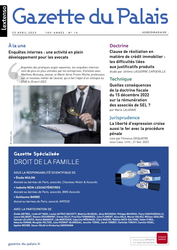
♾️follow Marie-Anne Frison-Roche on LinkedIn
♾️subscribe to the Newsletter MAFR Regulation, Compliance, Law
____
► Full Reference: M.-A. Frison-Roche & M. Boissavy, "Enquêtes internes : une activité en plein développement pour les avocats" ("Internal investigations: a growing business for attorneys"), interview with Miren Lartigue, Gazette du Palais, 25 April 2023.
____
💬read the interview (in French)
____
► Presentation of the interview by the journal (in French): "Inspirées des Anglo-saxons et boostées par la loi Sapin II du 9 décembre 2016, les enquêtes internes sont de plus en plus utilisées par les entreprises françaises pour vérifier la réalité de pratiques douteuses en leur sein, découvertes ou alléguées. Parce qu’il s’agit d’un nouveau champ d’activité pour les avocats, le Conseil national des barreaux (CNB) y a consacré une journée lors de son colloque organisé les 20 et 21 avril 2023 sur le thème « Avocat et droits de la défense dans les enquêtes internes et la justice négociée », qui a réuni 750 participants sur deux jours. Matthieu Boissavy et Marie-Anne Frison-Roche, qui ont participé à l’organisation de cet évènement, nous expliquent les contours de ce nouveau métier."
____
► Questions asked (in French):
- Quels sont la place et le rôle de l’avocat dans les enquêtes internes et pourquoi le CNB a-t-il souhaité organiser une journée consacrée à ce sujet ?
- Quel est leur rôle dans la réception des alertes ?
- Et dans l’enquête interne proprement dite ?
- Quelle est la complémentarité de l’avocat avec le juriste interne ?
- Quels sont outils utilisés pour le calcul des préjudices, la collecte et le traitement des données ?
- Comment s’applique la déontologie de l’avocat ?
- Et qu’en est-il des droits de la défense ?
- Quelle est l’étendue du secret professionnel de l’avocat ?
________
April 3, 2023
Interviews

♾️follow Marie-Anne Frison-Roche on LinkedIn
♾️subscribe to the Newsletter MAFR Regulation, Compliance, Law
____
► Full Reference: M.-A. Frison-Roche & M. Boissavy, "Colloque : « Avocat et droits de la défense dans les enquêtes internes et la justice négociée »" ("Symposium: "Lawyers and rights of the defence in internal investigations""), interview with Olivia Dufour, Actu-Juridique, 3rd April 2023.
____
💬read the interview (in French)
____
► Presentation of the interview by the journal (in French): "Le Conseil national des barreaux (CNB) organise les 20 et 21 avril prochains un colloque intitulé « Avocat et droits de la défense dans les enquêtes internes et la justice négociée ». Matthieu Boissavy, avocat aux barreaux de Paris et de New York, médiateur et vice-président de la commission Libertés et droits de l’Homme du Conseil national des barreaux et Marie-Anne Frison-Roche, professeure de droit, directrice du Journal of Regulation and Compliance nous expliquent les enjeux de ces nouvelles pratiques judiciaires qui bousculent le rôle traditionnel des acteurs de la justice, qu’il s’agisse des avocats ou des magistrats."
____
► Questions asked (in French):
- Le CNB organise les 20 et 21 avril prochains un colloque sur le thème : Avocats et droits de la défense dans les enquêtes internes et la justice négociée. Pourquoi ce choix ?
- La compliance n’est-elle pas en train de bouleverser le métier d’avocat ?
- Comment cela se traduit-il en pratique ?
- Quelles sont les implications déontologiques, ne faut-il pas inventer de nouvelles règles ?
- Qu’est-ce que la CJIP a changé dans le métier d’avocat ?
- Quels sont les nouveaux risques pour l’avocat ?
- Cela modifie-t-il les relations entre avocats, parquet et juges du siège ?
________
March 23, 2023
Thesaurus : Doctrine
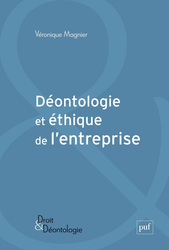
► Référence complète : V. Magnier, Déontologie et éthique de l'entreprise, PUF, coll. "Droit & Déontologie", 2023, 260 p.
____
📗lire la 4ième de couverture de l'ouvrage
____
📗lire la table des matières de l'ouvrage
____
► Résumé de l'ouvrage (fait par l'éditeur) : "La déontologie et l'éthique d'entreprise naissent de sources éparses, embrassent un large champ thématique et s'étendent à de nombreux acteurs.
Le conflit d'intérêts est au coeur des préoccupations déontologiques de l'entreprise, comme en témoignent les procédures pesant sur ses acteurs-clés, dirigeants et actionnaires de référence. Les bonnes pratiques de gouvernance, inspirées des théories sur la gouvernance d'entreprise, se muent aussi en règles déontologiques consignées dans les codes de gouvernance. L'entourage des actionnaires n'est pas épargné, notamment les agences de conseil en vote sur qui pèsent des règles déontologiques.
L'éthique d'entreprise est aussi en plein essor. On distingue l'éthique de la transparence, celle des compliances et celle de la vigilance. Ces nouvelles normes éthiques suscitent de fortes attentes, notamment au regard des préoccupations sociétales, environnementales, de la défense des droits de l'homme ou de la lutte contre la corruption.".
June 4, 2022
Thesaurus : Doctrine
► Référence complète : J.-F. Pillebout, "Réforme de la déontologie et de la discipline – Ordonnance du 13 avril 2022 – Décret du 13 avril 2022", JurisClasseur Notarial Formulaire, fasc. 36, 4 juin 2022.
____
► Résumé de l'article (fait par le Journal of Regulation & Compliance) :
________
June 12, 2020
Thesaurus : Soft Law
► Full Reference: Conseil national des barreaux (CNB) and Centre de recherche et d'étude des avocats (CREA), Guide. L'avocat français et les enquêtes internes (Guide. The French attorney and the internal investigations), June 2020.
____
► read the guide (in French)
________
Dec. 2, 2017
Blog

Le journal Le Monde dans son édition du 2 décembre 2017 raconte un cas, sans doute inédit, que le journaliste a lui-même lu dans une revue de médecine. Aussi repris par d'autres journaux, comme L'express.
Mais prenons le cas d'une façon plus juridique.
Et que l'on soit en système juridique de Common Law ou en système de Civil Law, un cas inédit est toujours une occasion de réfléchir.
LE CAS
En l'espèce, arrive à l’hôpital de Miami un homme de 70 ans. Il n'a plus conscience, non pas du fait de son âge mais en raison de l'alcool et n'a pas de papier d'identité. L'équipe médicale s'apprête à le réanimer, ce qui est techniquement est l'acte qui s'impose. Mais sur sa peau est tatouée la mention : "ne pas réanimer", le mot "pas" étant souligné et la mention étant signée.
LA QUESTION
Que doit faire le médecin ?
L'ANALYSE JURIDIQUE DU CAS POUR RÉPONDRE A LA QUESTION
La difficulté tient dans l'analogie à faire ou non entre un tatouage et d'autres modes d'expression de la volonté d'une personne.
En effet, lorsqu'une personne "parle", ou "écrit", elle exprime un "consentement", qui lui-même traduit en principe une volonté libre et éclairée. C'est le socle de la relation entre le médecin et le patient.En conséquence de quoi, si le patient exprime sa volonté de n'être pas réanimé, le médecin suivra cette expression de la volonté faite par le consentement.
Pourquoi l'analogie entre un tatouage et ce schéma pose problème ?
- à première vue, l'on peut dire que l'être humain s'exprime par d'autres mots que la parole et l'écrit. Ainsi, il y a de la jurisprudence pour dire que mettre une croix est une "signature" valable dès l'instant que le lien peut être fait entre "consentement" et la "volonté" est fait.
De la même façon, dans nos temps moderne, où l'écrit recule, pourquoi ne pas s'exprimer par le chant ? par une vidéo ? par un jeu où un avatar serait en train de mourir ? Pourquoi non ?
Car il n'y a pas de liste close sur la façon d'exprimer sa libre façon d'exprimer sa volonté, sur le mode d'expression de consentir.
Mais
Le problème vient justement du fait que ce lien entre cette expression ici exposée et ce qui est absolument être la source, à savoir une libre volonté maintenue de mourir, n'est pas acquis.
En effet, c'est la qualité de la volonté , exprimée d'une façon ou d'une autre, qu'il s'agit d'apprécier :
- Il doit s'agir d'une volonté maintenue de mourir. Pour s'en assurer, il faut que la personne puisse à tout moment renoncer à l'expression faite de mourir, par exemple en déchirant le papier, en faisant une déclaration contraire (en modifiant la déclaration faite au registre tenu par les services médicaux ad hoc). Or, le tatouage est définitif. Il ne permet pas techniquement cela; En cela, il ne peut pas techniquement exprimer une volonté maintenue. Et cela pour une raison paradoxale : c'est en tant qu'il est "définitif" qu'il n'existe pas une volonté chaque jour maintenue parce que chaque jour rétractable.
- Il doit s'agit d'une volonté librement et clairement exprimée. Dans les procédures d'écrits ou de prise de parole (car toutes ces "façons de faire" sont des "procédures"), l'on s'assure que la personne par son comportement (signer, relire, répéter, avoir des témoins, etc.) exprime sa volonté, emploie des mots pour le faire (par exemple : "je veux"). Certes, il y avait le soulignement du "pas" et une signature. Mais les tatouages sont parfois, voire souvent fait dans des circonstances où la personne ne se maîtrise plus tout à fait (sur quelle partie du corps ce tatouage était-il fait ?...). Or, lorsque la personne est arrivée à l'hopital, l'état d'ivresse était arrivée. Nous manquent deux éléments de fait : l'ancienneté ou non du tatouage ; la localisation du tatouage.
LA SOLUTION JURIDIQUE
Il n'y a pas de solution déjà arrêtée que l'on pourrait recopier,, tel l'élève sage. Il faut donc remonter plus haut, dans les normes fondamentales.
Il y en a deux : l'obligation du médecin de sauver les êtres humains (c'est son premier principe) ; la liberté de l'être humain de mourir (c'est sa première liberté).
Le cas met donc face à face deux principes fondamentales : la liberté de l'être humain d'une part (mourir), ce pour quoi les médecins sont faits (sauver).
Mais ici, il est acquis qu'il n'y a pas de doute sur le fait que les médecins étaient devant une personne qui allait mourir s'ils ne réanimaient pas. Alors qu'il y a un doute sur le fait que la personne dans l'expression qui est recueillie exprime véritablement sa volonté.
Il est incontestable que la question est donc une question probatoire.
C'est donc le principe qui est factuellement certain, face au principe qui est factuellement incertain, qui doit l'emporter.
La personne devait être réanimée.
QUE S'EST-IL PASSE EN L’ESPÈCE ?
Les médecins, dépassés et sans doute craignant une action en responsabilité, ont saisi le service de "l'éthique". Qui a dit que c'est "comme" un véritable message exprimant la volonté du patient. Celui-ci, non réanimé, est donc mort.
CONCLUSION : il faudrait apprendre aux médecins à faire des cas pratiques au regard des principes de droit.
Oct. 20, 2017
Thesaurus : 01. Conseil constitutionnel
Aug. 26, 2016
Thesaurus : Doctrine
Référence complète : PANDO, A., Lutte anti-blanchiment : les sanctions contre les agents immobiliers pourraient se durcir, Les Petites Affiches, n°170, 26 août 2016, p.4-6.
Les étudiants de Sciences po peuvent lire l'article va le drive dans le dossier MAFR - Régulation.
L'auteur expose l'activation du système mis en place en 2009 pour lutter contre le blanchiment d'argent, dispositions aujourd'hui contenues dans le Codes Monétaire et Financier.
Il souligne que les "professions orphelines", c'est-à-dire sans instance ordinale vont, du fait des attentats, être plus surveillées dans leur collaboration avec les autorités publiques : elles "ne vont plus échapper aux contrôles de leur compliance anti-blanchiment", parce que la Commissions Nationale des Sanctions commence à bouger.
L'AAI mise en place en 2009 et jusqu'ici peu active, la "Commission Nationale des Sanctions" (CNS) a publié son premier rapport, publiant ainsi des sanctions contre les agents immobiliers après des contrôles de ceux-ci par la DGCCRF.
L'auteur souligne que la profession d'agent immobilier est peu préparée à être active pour porter les obligations de détection et d'information en matière de blanchiment. Le plus souvent, ils en ignorent l'existence.
Dans son rapport, la CSN affirme que pour l'instant elle s'en tient à la "pédagogie" et prononce des blâmes mais prévoit qu'elle va devenir plus sévère. La profession dit que le système ne lui est pas adapté et qu'ils "se sentent déchargés de toutes obligations de vigilance par l'intervention des notaires qui concluent les transactions".
De toutes les façons le système français va étendre les professions non financières contraintes, à travers l'application de la 4ième directive communautaire anti-blanchiment, par exemple les marchands de pierres précieuses.
L'auteur suggère une pareille extension aux agents sportifs.
June 16, 2016
Thesaurus : Doctrine
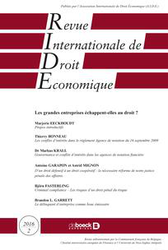
Référence complète : Eeckhoudt, M. (dir.), Les grandes entreprises échappent-elles au droit, Revue Internationale de Droit Économique (RIDE), 2016/2,De Boeck, (introduction, par Marjorie Eeckhoudt, p. 151-163.).
Les étudiants de Sciences po peuvent lire l'article via le drive dans le dossier "MAFR - Régulation" les différents articles qui constituent le dossier.
L'auteur présente dans l'introduction le dossier consacré à l'articulation entre la compliance et la responsabilité pénale.
Elle y voit l'importation du droit américain dans un "copier-traduire-coller". Elle y voit à la fois la puissance du droit et un moyen pour les grandes entreprises qui multiplient les chartes d'échapper aux droits nationaux.
Elle estime que cela participe des "divers instruments de la régulation", assistant notamment à un retour de la réglementation, par exemple à propos des agences de notation et la règle comply or explain.
Or, "compliance rime avec indépendance" (p.158) et l'agence de notation n'est pas toujours indépendance de son client : c'est pourquoi le conflit d'intérêts est au cœur de la compliance. "compliance rime avec transparence" (p.158).
L'auteur explique le souci d'efficacité guide aussi désormais la responsabilité pénale, à travers la négociation pénale ou l'accueil du lanceur d'alerte. Mais l'efficacité n'est encore la mieux servie en matière de sanction.
Dans ce dossier voir aussi :
BONNEAU Thierry, Les conflits d'intérêts dans le règlement Agence de notation du 16 septembre 2009.
KRALL Markus, Gouvernance et conflits d'intérêts dans les agences de notation financière.
FASTERLING Björn, Criminal compliance - Les risques d'un droit pénal du risque.
GARRETT Brandon L., Le délinquant d'entreprise comme bouc émissaire.
_____
March 10, 2016
Conferences

► Full Reference: M.-A. Frison-Roche, "Le Diable dans la bouteille des Codes de bonne conduite" (The Devil in the bottle of Codes of Conduct). Hommage to Gérard Farjat, Center of Economic Law, Nice, France, 10 March 2016 .
____
► see the conference . (in French)
► see the construction of this conference (in French)
► see the media/assets/slides/les-codes-de-bonne-conduite.pdf"> slides, used as basis for this conference (in French).
____
► English presentation of this conference: In 1978, our mutual friend Gérard Farjat wrote a memorable article on "les codes de conduite privés" ('private codes of conduct') (in French), codes of conduct which have since flourished. I remember that it worried him because he was aware of the rhetoric, and even the contradiction, that these codes contain, and at the same time he did not see what could stop this legitimate way for international companies to organise an 'order' at home, since the Law was no longer able to offer them one from the outside, nor was Law capable of limiting the less virtuous tendency of companies to fashion norms by which they exercise power not only to organise themselves but also to govern others and the outside world.
When Gérard Farjat wrote this article in 1978, Corporate Social Responsibility had not yet been conceived...
Have we reached the same point? Can we even say that the situation has worsened, with the world being "standardised" and "governed" by "global" companies that write and impose codes of "good" conduct that express what is "good" in itself and end up constituting veritable "global constitutions"?
No. In fact, the opposite is true. Through the power of Regulators and Supervisors, institutions of public authority, public standards are internalised in "global" companies, which repeat them in codes of conduct and become their own regulators and supervisors.
________
Dec. 9, 2014
Conferences
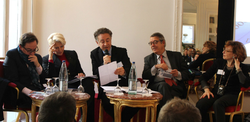
Lire l'article qui rendit compte de la manifestation.
Voir des extraits de la manifestation.
Il fût un temps où les "codes d'éthique" n'existaient pas et l'on s'en portait aussi bien. Quand ils sont apparus, moqueries et critiques les accueillirent. Moqueries car ils n'étaient que redondance. En effet et par exemple, affirmer l'engagement de respecter le droit n'aurait aucun sens car respecter le droit est une obligation préexistante à toute déclaration de soumission. Critiques car ils apparurent comme un mode d'internalisation du pouvoir normatif, c'est-à-dire un mode de capture du pouvoir législatif. L'entreprise devenue Portalis ...
Peut-être. Mais aussi les temps ont-ils changé, qui font pâlir ces remarques acerbes. En effet, la soumission à la loi n'est pas un acquis. La normativité peut se partager si l'exercice qu'en fait l'entreprise aboutit à ne pas contredire l'autonomie du Politique, voire la complète, peut-être la renforce.
Ici, le corps de prescription de comportements sanctionnés, c'est-à-dire la régulation, n'est pas interne à une entreprise, ou à un secteur, mais à une "profession" commune à toutes les entreprises. Il est probable que la notion d'"entreprise" soit amenée à se développer, sorte renouvelée de corps intermédiaire, dans le grand désert de la mondialisation.
L'enjeu dès lors est pour les "juristes d'entreprise" d'être véritablement une "profession". Cela n'est pas si clair lorsque la profession est "réglementée", mais enfin lorsque le Politique la nomme ainsi, cela la constitue. Lorsqu'elle se désigne ainsi, alors l'autorégulation résulterait en outre de l'autodésignation ...
Pour être une profession, il faut avoir une unicité commune à l'intérieur du groupe, et une hétéronomie par rapport à l'extérieur. La difficulté tient surtout dans cette seconde exigence, dans la mesure où cet extérieur peut être pour le "juriste d'entreprise" l'entreprise elle-même. C'est alors que l'ordre se renverse car c'est le Code d'éthique qui peut permettre aux juristes d'entreprise de prendre distance par rapport à la hiérarchie de l'entreprise et d'exister ainsi comme profession. Cela renvoie aussi à une nouvelle conception de l'entreprise, moins hiérarchisée. En cela, l'éthique de la profession du juriste d'entreprise renvoie aux fondements de la Corporate Social Responsability, laquelle suppose une entreprise conçue comme un groupe non-hiérarchisé.
Nov. 3, 2014
Thesaurus : 03. Décrets, réglements et arrêtés
Oct. 9, 2014
Publications
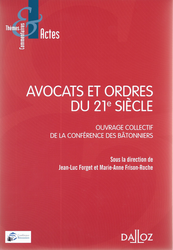
► Référence complète : M.-A. Frison-Roche, "Avocat et ordre. Être moderne sans se perdre" du droit", in J.-L. Forget et M.-A. Frison-Roche (dir.).Avocats et ordres du 21e siècle, coll "Thèmes et commentaires", Dalloz, 2014, p. 199-222.
____
____
📕lire une présentation de l'ouvrage dans lequel l'article est publié
____
► Résumé de l'article : L'avocat s'est construit, se définit et continuera de se définir par sa déontologie, dont l'Ordre est le concepteur et le gardien. Cette déontologie a en son cœur l'indépendance de l'avocat, une indépendance qui le marque et le distingue. Cette force explique l'intimité qui existe entre l'avocat et l'Ordre auquel il appartient et dont il dépend, les règles que l'Ordre lui applique devant lui demeurer intimes.
Cela n'empêche en rien que le droit a une valeur économique et que le cabinet d'avocat est une entreprise, rendant un service et supportant des coûts. Plus encore, la rentabilité de cette entreprise est d'autant plus nécessaire que l'avocat doit, par devoir et donc par nature, assurer des tâches qui ne sont pas rentables, comme l'aide au plus faible.
C'est pourquoi les enjeux de la profession d'avocat sont les mêmes que les enjeux des Ordres : il s'agit de développer l'esprit d'entreprise dans tous les cabinets d'avocats, que l'Europe les porte et que les technologies les aide. De la même façon, les Ordres doivent permettre aux avocats de demeurer ce qu'ils sont par essence sans en mourir économiquement, c'est-à-dire ceux qui défendent et conseillent en échange de rien ni dépendre de personne. Cela nécessite un dialogue renouvelé aussi bien avec les compagnies d'assurance qu'avec les pouvoirs publics, l'aide juridictionnelle autant aussi bien question d'argent que question de valeur fondamentale.
________
Oct. 3, 2013
Conferences
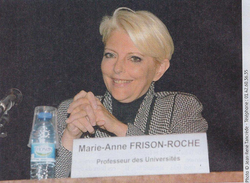
L'ensemble des travaux a donné lieu à la publication d'un ouvrage, paru aux Éditions Dalloz, dans la collection "Thèmes et Commentaires", Avocats et Ordres du 21ième siècle.
Updated: July 31, 2013 (Initial publication: Nov. 8, 2011)
Teachings : Les Grandes Questions du Droit, semestre d'automne 2011

Jan. 6, 2011
Publications
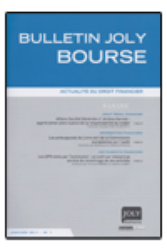
Référence complète : FRISON-ROCHE, Marie-Anne, Les présupposés du Livre Vert de la Commission européenne sur l'audit, Bulletin Joly Bourse, janvier 2011, p.47-54
Le Livre Vert de la Commission européenne publié le 12 octobre 2010, consacré à l’audit est construit sur des présupposés qu’elle n’ouvre pas à la discussion.
Ainsi, sous prétexte que l’audit des comptes a une influence déterminante sur les marchés, elle en conclut que l’entreprise d’audit est de nature systémique si elle est de grande taille et doit être traitée avec la même prévention qu’implique le risque de faillite, ce qui justifierait la déconcentration du marché de l’audit.
Mais l’auditeur n’est systémique qu’au sens positif en tant qu’il est influent et non pas au sens négatif au sens où sa défaillance serait contagieuse. Donc, on ne doit pas le traiter par un régime analogue à celui appliqué aux banques et notamment pas affaiblir les agents puissants. Au contraire, la concurrence conduirait l’auditeur à moins bien résister à la pression des dirigeants soumis par la loi au contrôle. Il faut donc non pas de la concurrence mais de la régulation à long terme.
Sept. 3, 2010
Conferences

C’est à partir de l’identité de l’avocat, telle qu’elle est actuellement et telle que les avocats veulent eux même qu’elle se profile que la profession doit se dessiner et se gouverner.
Par un mouvement en retour, la gouvernance de la profession s’appuie sur la notion très particulière de profession, groupe de personnes qui se reconnait comme appartenant à un ensemble distinct des acteurs atomisés de la société générale ou du marché par l’adhésion, à un ensemble de valeur, notamment déontologique.
Ainsi, les ordres et les structures d’enseignement doivent inculquer aux jeunes avocats l’idée même de leur identité et le sentiment d’appartenance à une profession, laquelle ne les conduit en rien à être hors marché, mais bien au contraire à constituer par ses valeurs morales de crédibilité un tiers de confiance.
Les ordres sont donc des sortes de régulateurs de la profession mettant en équilibre une organisation interne la plus efficace possible et une action économique externe la plus bénéfique possible tant que cela ne porte pas atteinte aux libertés et droits fondamentaux car avant tout l’avocat a pour identité d’être, comme le juge, celui qui défend le faible et, y compris contre l’État les droit et libertés fondamentaux.
Regarder les slides ayant servi de support à la conférence.
Cette conférence à servi de support à un entretien dans Le Journal des Bâtonniers de novembre-decembre-janvier 2010 : lire l'article,
Lire ci-dessous un développement du thème.
Dec. 16, 2004
Publications
June 20, 2001
Publications
Direction scientifique de Le secret professionnel, n° spécial des Petites Affiches, 20 juin 2001.
Lire l'article d'introduction.